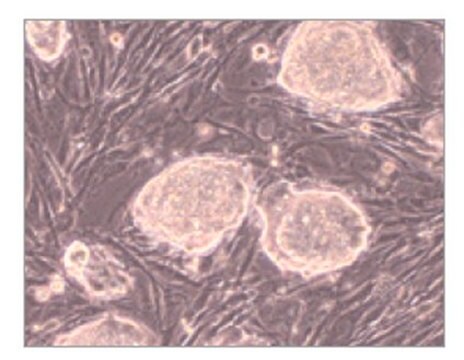PMEF-DR4-M
EmbryoMax® Primary Mouse Embryonic Fibroblasts
PMEF, Strain DR4, Mitomycin C Treated, Passage 3
Synonyme(s) :
MEF Feeder Cells, DR4 PMEFs, DR4 MEFs, MEFs, Mouse Feeder Cells
Se connecterpour consulter vos tarifs contractuels et ceux de votre entreprise/organisme
About This Item
Code UNSPSC :
41106514
eCl@ss :
32011203
Produits recommandés
Source biologique
mouse
Niveau de qualité
Fabricant/nom de marque
Specialty Media
EmbryoMax®
Technique(s)
cell culture | stem cell: suitable
Description générale
Plating MEF Feeder Cells
Procedure:
1. Prior to thawing PMEF feeder cells, coat plates/flasks with Gelatin solution.
2. Thaw PMEF vial(s) quickly in a 37 °C water bath and transfer to a 15 mL tube (already containing 10 mL of warm PMEF Feeder Cell Medium). Gently invert the tube to distribute, and centrifuge at 300 xg for 4–5 minutes.
3. Remove supernatant and resuspend the cell pellet in warm PMEF Feeder Cell Medium.
4. Remove the Gelatin solution from plates/flasks, and aliquot the PMEF feeder cell suspension at the densities recommended in Table 4.1 of the mouse ES protocol guide
5. Incubate the PMEF Feeder cells at 37 °C with 5% CO2. Use Figures 4A, B and C in the mouse ES protocol guide as a guide for an estimate of correct PMEF density and
appearance. Gelatinized plates may be used for 12–14 days.
Procedure:
1. Prior to thawing PMEF feeder cells, coat plates/flasks with Gelatin solution.
2. Thaw PMEF vial(s) quickly in a 37 °C water bath and transfer to a 15 mL tube (already containing 10 mL of warm PMEF Feeder Cell Medium). Gently invert the tube to distribute, and centrifuge at 300 xg for 4–5 minutes.
3. Remove supernatant and resuspend the cell pellet in warm PMEF Feeder Cell Medium.
4. Remove the Gelatin solution from plates/flasks, and aliquot the PMEF feeder cell suspension at the densities recommended in Table 4.1 of the mouse ES protocol guide
5. Incubate the PMEF Feeder cells at 37 °C with 5% CO2. Use Figures 4A, B and C in the mouse ES protocol guide as a guide for an estimate of correct PMEF density and
appearance. Gelatinized plates may be used for 12–14 days.
The EmbryoMax range of PMEF cells provides researchers with a convenient solution for ES cell culture by eliminating the need for time consuming feeder cell isolation and preparation. Many embryonic stem cell culture protocols necessitate the use of primary mouse embryo fibroblast (PMEF) cells. In these protocols, ES cells are typically cultured on a monolayer of PMEF feeder cells. Feeder cells perform two important roles in stem cell culture: they secrete several important growth factors into the medium, which help maintain pluripotency, and they provide a cellular matrix for ES cells to grow.
The DR4 strain of MEF feeder cells are resistant to neomycin, hygromycin, puromycin, and 6-thioguanine. They are mitotically arrested by mytomycin-C treatment and will not proliferate.
The DR4 strain of MEF feeder cells are resistant to neomycin, hygromycin, puromycin, and 6-thioguanine. They are mitotically arrested by mytomycin-C treatment and will not proliferate.
Description de la lignée cellulaire
Primary Mouse Embryo Fibroblasts
Composants
EmbryoMax PMEF, P3, Strain DR4, Mito-C Treated: (Part number PMEF-DR4) One (1) vial containing ≥4 x10^6 cells per vial.
Qualité
Cell Viability and Morphology: PASSED
Mycoplasma Testing: PASSED
Bacterial Testing: PASSED
Fungi Testing: PASSED
Mycoplasma Testing: PASSED
Bacterial Testing: PASSED
Fungi Testing: PASSED
Stockage et stabilité
Vials should be stored in the vapor phase of liquid nitrogen.
Informations légales
EmbryoMax is a registered trademark of Merck KGaA, Darmstadt, Germany
Code de la classe de stockage
12 - Non Combustible Liquids
Classe de danger pour l'eau (WGK)
WGK 1
Point d'éclair (°F)
Not applicable
Point d'éclair (°C)
Not applicable
Certificats d'analyse (COA)
Recherchez un Certificats d'analyse (COA) en saisissant le numéro de lot du produit. Les numéros de lot figurent sur l'étiquette du produit après les mots "Lot" ou "Batch".
Déjà en possession de ce produit ?
Retrouvez la documentation relative aux produits que vous avez récemment achetés dans la Bibliothèque de documents.
Notre équipe de scientifiques dispose d'une expérience dans tous les secteurs de la recherche, notamment en sciences de la vie, science des matériaux, synthèse chimique, chromatographie, analyse et dans de nombreux autres domaines..
Contacter notre Service technique


